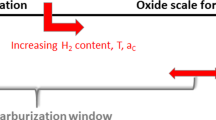Conclusions
-
1.
In freshly prepared endothermic mixture, the mass transfer coefficient is larger than in a mixture with previous cooling of the endogas, on account of the presence of active radicals which disintegrate upon cooling. An effect analogous to cooling is obtained when the water vapor concentration in the air is high.
-
2.
The mass transfer coefficient in decarburization in moistened hydrogen and in carburization in products of conversion of natural gas by water vapor, and also in endothermic mixture obtained by the traditional method, has to be calculated by Eq. (5).
-
3.
The mass transfer coefficient of products of conversion of natural gas by carbon dioxide and of freshly prepared endothermic mixture has to be calculated by Eq. (6).
Similar content being viewed by others
Literature cited
V. A. Munts et al., "Instrument for measuring and controlling the carbon potential of gaseous media," Metalloved. Term. Obrab. Met., No. 5, 28 (1978).
M. E. Blanter, "Determination of the diffusion coefficient in iron alloys," Zavod. Lab.,12, No. 3, 296 (1946).
A. A. Samarskii, The Theory of Difference Schemata [in Russian], 2nd ed., Nauka, Moscow (1977).
S. L. Kiperman, Introduction to the Kinetics of Heterogeneous Catalytic Reactions [in Russian], Nauka, Moscow (1964).
S. Wunning, Harterei-Technische Mitteilungen,23, No. 2, 101 (1968).
F. Neumann and U. Wyss, Harterei-Technische Mitteilungen,15, No. 4, 253 (1970).
E. L. Gyulikhandanov and V. V. Kislyakov, "Determination of the specific reaction rate during treatment of steel in an endothermic atmosphere," Izv. Akad. Nauk SSSR, Met., No. 3, 189 (1978).
G. M. Gitman, G. D. Zakharenko, and M. A. Geller, "Intensification of the carburization of steel in a fluidized bed of catalyst in case-hardening and nitrogen casehardening," in: Heat and Mass Transfer in Two-Phase Systems during Phase and Chemical Transformation, Trudy ITMO (1976), p. 144.
B. I. Rauzin and L. A. Mikhailov, "Determination of the optimum speed of circulation of the atmosphere during case-hardening," Metalloved. Term. Obrab. Met., No. 11, 33 (1971).
Additional information
S. M. Kirov Ural Polytechnic Institute. Translated from Metallovedenie i Termicheskaya Obrabotka Metallov, No. 2, pp. 21–24, February, 1983.
Rights and permissions
About this article
Cite this article
Munts, V.A., Baskakov, A.P. Mass exchange in carburization and decarburization of steel. Met Sci Heat Treat 25, 98–102 (1983). https://doi.org/10.1007/BF00777027
Issue Date:
DOI: https://doi.org/10.1007/BF00777027



